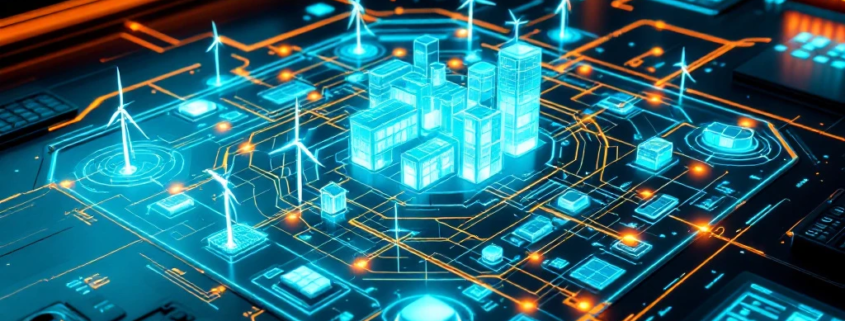What Innovations Are Driving the Future of Energy Automation?
The energy sector is undergoing rapid transformation through advanced automation technologies that enhance efficiency, reliability, and sustainability. Smart grid solutions, industrial IoT integration, and sophisticated control systems are revolutionizing how energy is produced, distributed, and managed. These cutting-edge technologies enable real-time monitoring, predictive maintenance, and seamless integration of renewable resources while optimizing performance across complex energy ecosystems. With specialized communication protocols like CAN bus forming the backbone of these systems, automation innovations are creating more resilient, flexible, and future-ready energy infrastructure.
What is driving the evolution of energy automation systems?
The transformation of energy automation systems is propelled by several powerful forces converging in today’s rapidly changing landscape. Sustainability imperatives stand at the forefront, with international agreements and corporate commitments demanding more efficient, cleaner energy production and consumption patterns. These environmental goals have created urgent need for sophisticated control mechanisms.
Simultaneously, digitalization has dramatically expanded what’s possible in energy management. The proliferation of sensors, advanced analytics, and connectivity solutions enables unprecedented visibility and control across energy infrastructure. This digital foundation supports more responsive, data-driven operations that were impossible just years ago.
Energy systems themselves are becoming substantially more complex. The traditional one-way flow of electricity from centralized power plants to consumers has given way to multidirectional networks incorporating distributed generation, storage systems, and flexible loads. This complexity demands increasingly sophisticated automation to maintain stability, optimize efficiency, and ensure reliability.
Market deregulation and competitive pressures are further accelerating innovation, as energy providers seek technology-driven advantages to differentiate services and reduce operational costs while meeting heightened consumer expectations for reliability and environmental performance.
How is CAN bus technology transforming energy management systems?
CAN bus technology has emerged as a foundational element in modern energy management systems, offering robust communications infrastructure that withstands the demanding conditions of energy environments. This technology, originally developed for automotive applications, provides exceptional reliability through error detection capabilities and fault-tolerant design – critical features when managing essential energy services.
The distributed architecture of CAN bus systems enables sophisticated control mechanisms across widely dispersed energy assets. Multiple controllers can communicate with minimal latency, allowing for coordinated responses to changing conditions without relying on centralized processing. This distributed intelligence creates more resilient systems that can maintain operation even when individual components experience issues.
Standardization represents another significant advantage. CAN bus protocols facilitate seamless integration between diverse equipment from different manufacturers, allowing energy companies to build systems using best-in-class components without compatibility concerns. This interoperability reduces integration costs and future-proofs investments as energy infrastructure evolves.
For companies like TK Engineering Oy, expertise in CAN bus technology enables the development of tailored automation solutions that can scale effectively across complex energy systems while maintaining the reliability essential for critical infrastructure.
What role does IoT play in next-generation energy automation?
Industrial IoT represents a transformative force in energy automation, creating intelligent networks of connected devices that continuously generate valuable operational data. These systems enable comprehensive real-time monitoring across distributed energy assets, providing operators with immediate visibility into performance metrics, potential issues, and changing conditions. With properly deployed IoT architecture, energy systems become transparent and manageable at previously impossible scales.
Predictive maintenance capabilities stand among the most valuable applications of IoT in energy settings. By analyzing patterns in equipment performance data, sophisticated algorithms can identify early warning signs of potential failures before they cause disruptions. This approach shifts maintenance from reactive to proactive, dramatically reducing unexpected downtime and extending asset lifecycles.
The true power of IoT emerges through data-driven optimization. The massive datasets generated by connected sensors feed advanced analytics systems that continuously identify efficiency improvements, load balancing opportunities, and operational refinements. These insights drive both automated adjustments and strategic decision-making that enhances overall system performance.
Together, these capabilities create energy infrastructure that is not merely automated but genuinely intelligent – systems that can adapt to changing conditions, learn from operational patterns, and continuously improve performance metrics over time.
How are automation innovations addressing renewable energy integration challenges?
Renewable energy integration presents distinctive challenges that advanced automation solutions are uniquely positioned to address. The inherent variability of renewable sources like solar and wind creates grid stability concerns that traditional manual control systems struggle to manage. Modern automation technologies employ sophisticated forecasting algorithms and rapid-response control mechanisms to maintain balance between supply and demand despite fluctuating inputs.
Energy storage management represents another critical area where automation excels. Intelligent systems optimize charging and discharging cycles to maximize storage efficiency, extend battery lifecycles, and ensure capacity is available when most valuable. These systems coordinate multiple storage assets while considering factors like grid conditions, energy prices, and anticipated demand patterns.
The distributed nature of renewable generation requires automation solutions capable of coordinating numerous small-scale assets functioning as cohesive systems. Advanced control networks enable these scattered resources to operate in concert, responding to grid needs and market signals as unified entities rather than isolated components.
Through these capabilities, automation innovations are transforming renewable energy from a grid management challenge into a valuable, reliable resource – accelerating the transition toward more sustainable energy systems while maintaining dependable service.
What benefits can companies expect from implementing modern energy automation solutions?
Organizations implementing advanced energy automation technologies typically realize multifaceted benefits spanning operational, financial, and sustainability dimensions. Operational improvements often appear most immediately, with automation delivering enhanced reliability through continuous monitoring, anomaly detection, and responsive controls that prevent minor issues from escalating into major problems.
Efficiency gains represent another significant benefit area. Automated systems optimize energy flows, reduce waste, and ensure resources are utilized at peak effectiveness. These improvements translate directly into cost savings while simultaneously reducing environmental impact – a dual benefit increasingly valued by stakeholders.
The financial advantages extend beyond direct efficiency savings. Remote monitoring capabilities reduce the need for on-site personnel, while predictive maintenance extends equipment lifespans and prevents costly unplanned downtime. These factors combine to improve return on infrastructure investments while providing more predictable operational costs.
Perhaps most valuable in today’s rapidly evolving energy landscape is the flexibility that modern automation provides. Well-designed systems can adapt to changing conditions, incorporate new technologies, and scale to meet growing demands – ensuring companies maintain competitive advantage amid continuing transformation of energy markets and technologies.
Key takeaways for the future of energy automation
The landscape of energy automation continues to evolve rapidly, with several key innovations shaping its trajectory. Intelligent control systems with machine learning capabilities are increasingly able to optimize complex operations without human intervention. Seamless integration between operational technology and information technology is creating unprecedented visibility and coordination across previously siloed systems.
Edge computing architectures are moving processing power closer to the point of data generation, enabling faster responses and more resilient operations. Meanwhile, cybersecurity considerations are being integrated into automation designs from the ground up, protecting critical infrastructure from emerging threats.
TK Engineering’s specialized expertise in control systems and CAN bus technology positions forward-thinking companies to leverage these advancements effectively. By implementing robust, scalable communication infrastructures based on proven protocols, organizations can build automation systems that deliver immediate benefits while remaining adaptable to future innovations.
As energy systems continue growing more complex and distributed, the competitive advantage will increasingly belong to those who can implement automation solutions that enhance reliability, efficiency, and sustainability simultaneously – turning the challenges of energy transition into opportunities for operational excellence.
Want to optimize your energy infrastructure?
Check out our energy case studies to see how robust CAN topologies and modular designs enhance the reliability of modern energy systems.



